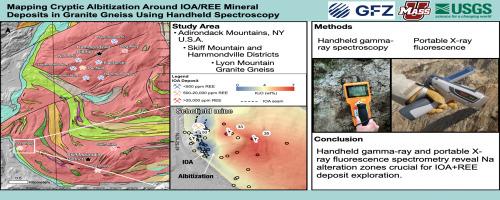Alteration mapping in granitic gneiss using handheld geophysical and geochemical instruments: Implications for iron oxide-apatite and rare earth elements exploration
引用次数: 0
Abstract
The Adirondack Mountains of New York, U.S.A. contain iron oxide-apatite (IOA) mineral deposits with variable concentrations of rare earth elements (REE). The IOA mineral deposits are typically hosted in the Lyon Mountain Granite Gneiss and are spatially correlated with extensive Na metasomatism (albitization) of the surrounding country rocks, although some mineral deposits also occur in metagabbro, paragneiss, and anorthosite hosts. The location of albitization zones is key to finding new IOA mineral deposits and better understanding the mineralization processes associated with their genesis. However, the Na alteration zones are generally not visibly identifiable in outcrop or hand specimens because the color and textural changes are subtle and are thus difficult to map. Here, we discuss the results from testing two spectroscopic techniques (handheld, field gamma-ray spectroscopy, and portable X-ray fluorescence (pXRF)) to characterize albitization zones surrounding IOA mineral deposits.
The gamma-ray and pXRF spectrometers successfully distinguished the relative intensity of alteration in the Lyon Mountain Granite Gneiss based on the K abundance. The measured K content decreases towards the IOA mineral deposits, and the magnitude and width of the gradient are similar along the strike of each mineral deposit. Elevated Th and U values are present in host rocks adjacent to REE-bearing IOA mineral deposits. The pXRF and gamma-ray spectrometer K values are remarkably consistent with laboratory-based, whole-rock XRF compositional data and, therefore, useful for semi-quantitative analysis. Notably, albitization aureoles are consistent around REE-rich and REE-poor mineral deposits, suggesting that saline fluids are essential for the petrogenesis of IOA mineral deposits but may not be critical to REE mineralization. Ultimately, this study demonstrates the utility of handheld gamma-ray and pXRF spectrometry for identifying otherwise cryptic albitization gradients associated with IOA mineral deposits in granitic gneiss.

手持地球物理和地球化学仪器在花岗质片麻岩中的蚀变填图:对氧化铁-磷灰石和稀土元素勘探的意义
美国纽约阿迪朗达克山脉含有含不同浓度稀土元素(REE)的氧化铁磷灰石矿床。IOA矿床通常赋存于里昂山花岗片麻岩中,与周围围岩广泛的钠交代作用(钠长岩化)在空间上相关,尽管一些矿床也赋存于变长岩、副长岩和斜长岩中。钠长岩化带的位置是寻找新的IOA矿床和更好地了解其成因的成矿过程的关键。然而,钠蚀变带通常在露头或手标本中无法明显识别,因为颜色和质地的变化很微妙,因此难以绘制。在这里,我们讨论了测试两种光谱技术(手持式、现场伽玛射线光谱和便携式x射线荧光(pXRF))的结果,以表征IOA矿床周围的钠长石化带。伽玛射线和pXRF光谱仪根据K丰度成功区分了里昂山花岗片麻岩的相对蚀变强度。测得的钾含量向IOA矿床方向递减,且沿各矿床走向梯度的大小和宽度相似。在含稀土IOA矿床附近的寄主岩中,Th和U值升高。pXRF和伽玛射线光谱仪的K值与基于实验室的全岩XRF成分数据非常一致,因此可用于半定量分析。值得注意的是,在富含稀土元素和缺乏稀土元素的矿床周围,钠长石化光晕是一致的,这表明含盐流体对IOA矿床的岩石形成至关重要,但对稀土矿化可能不是至关重要的。最后,本研究证明了手持式伽玛射线和pXRF光谱法在识别与花岗质片麻岩中IOA矿床相关的其他隐蔽的钠长石化梯度方面的实用性。
本文章由计算机程序翻译,如有差异,请以英文原文为准。
求助全文
约1分钟内获得全文
求助全文

 求助内容:
求助内容: 应助结果提醒方式:
应助结果提醒方式:


